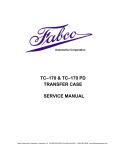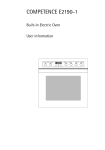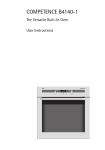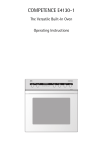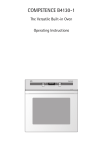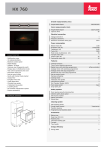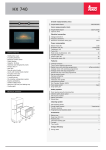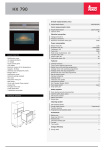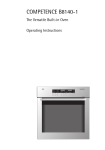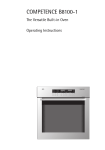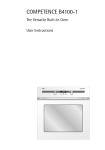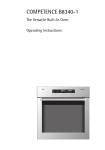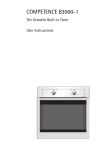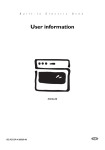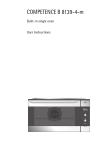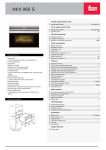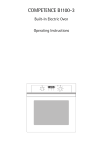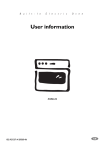Download B41421-m User Manual
Transcript
COMPETENCE B4142-1 Pyrolytic Self-Cleaning Electric Oven User information Dear customer, Please read these user information carefully. Pay particular attention to the section “Safety information” on the first few pages. Please retain this user information for later reference. Pass them on to possible new owners of the appliance. 1 3 2 The following symbols are used in the text: Safety instructions Warning: Information concerning your personal safety. Important: Information on how to avoid damaging the appliance. Information and practical tips Environmental information 1. These numbers indicate step by step how to use the appliance. 2. … 3. … This user information contain information on steps you can take yourself to rectify a possible malfunction. Refer to the section “What to do if...”. In the event of any technical problems please contact your nearest customer service centre at any time. (Addresses and telephone numbers may be found in the appendix under "Customer Service Centres“). You should also refer to the section "Service". Printed on recycled paper. Thinking ecologically means acting ecologically … 2 Contents Operating Instructions . . . . . . . . . . . . . . . . . . . . . . . . . . . . . . . . . . . . . 5 Safety . . . . . . . . . . . . . . . . . . . . . . . . . . . . . . . . . . . . . . . . . . . . . . . . . . . . . . . . . 5 Disposal . . . . . . . . . . . . . . . . . . . . . . . . . . . . . . . . . . . . . . . . . . . . . . . . . . . . . . . 6 Description of the Appliance . . . . . . . . . . . . . . . . . . . . . . . . . . . . . . . . . . . . . General Overview. . . . . . . . . . . . . . . . . . . . . . . . . . . . . . . . . . . . . . . . . . . . . . . . Control Panel . . . . . . . . . . . . . . . . . . . . . . . . . . . . . . . . . . . . . . . . . . . . . . . . . . . Oven Features. . . . . . . . . . . . . . . . . . . . . . . . . . . . . . . . . . . . . . . . . . . . . . . . . . . Oven accessories . . . . . . . . . . . . . . . . . . . . . . . . . . . . . . . . . . . . . . . . . . . . . . . . 7 7 8 8 9 Before Using for the First Time. . . . . . . . . . . . . . . . . . . . . . . . . . . . . . . . . . . 10 Setting the Time. . . . . . . . . . . . . . . . . . . . . . . . . . . . . . . . . . . . . . . . . . . . . . . . . 10 Initial Cleaning. . . . . . . . . . . . . . . . . . . . . . . . . . . . . . . . . . . . . . . . . . . . . . . . . . 11 Using the Oven . . . . . . . . . . . . . . . . . . . . . . . . . . . . . . . . . . . . . . . . . . . . . . . . . Switching the Oven On and Off . . . . . . . . . . . . . . . . . . . . . . . . . . . . . . . . . . . . Oven Functions. . . . . . . . . . . . . . . . . . . . . . . . . . . . . . . . . . . . . . . . . . . . . . . . . . Inserting the Shelf and Universal Baking Tray . . . . . . . . . . . . . . . . . . . . . . . . Inserting/Removing the Fat Filter . . . . . . . . . . . . . . . . . . . . . . . . . . . . . . . . . . Turnspit . . . . . . . . . . . . . . . . . . . . . . . . . . . . . . . . . . . . . . . . . . . . . . . . . . . . . . . . Clock Functions . . . . . . . . . . . . . . . . . . . . . . . . . . . . . . . . . . . . . . . . . . . . . . . . . Switching Off the Time Display . . . . . . . . . . . . . . . . . . . . . . . . . . . . . . . . . Oven safety cut-out. . . . . . . . . . . . . . . . . . . . . . . . . . . . . . . . . . . . . . . . . . . 12 12 13 15 16 17 19 21 27 Uses, Tables and Tips . . . . . . . . . . . . . . . . . . . . . . . . . . . . . . . . . . . . . . . . . . . . Baking . . . . . . . . . . . . . . . . . . . . . . . . . . . . . . . . . . . . . . . . . . . . . . . . . . . . . . . . . Baking Table . . . . . . . . . . . . . . . . . . . . . . . . . . . . . . . . . . . . . . . . . . . . . . . . . Pies and Gratin Table . . . . . . . . . . . . . . . . . . . . . . . . . . . . . . . . . . . . . . . . . . Frozen Ready Meals Table . . . . . . . . . . . . . . . . . . . . . . . . . . . . . . . . . . . . . . Roasting . . . . . . . . . . . . . . . . . . . . . . . . . . . . . . . . . . . . . . . . . . . . . . . . . . . . . . . Table for Roasting . . . . . . . . . . . . . . . . . . . . . . . . . . . . . . . . . . . . . . . . . . . . Using the Grills. . . . . . . . . . . . . . . . . . . . . . . . . . . . . . . . . . . . . . . . . . . . . . . . . . Grilling Table. . . . . . . . . . . . . . . . . . . . . . . . . . . . . . . . . . . . . . . . . . . . . . . . . Grilling with the turnspit . . . . . . . . . . . . . . . . . . . . . . . . . . . . . . . . . . . . . . Defrosting . . . . . . . . . . . . . . . . . . . . . . . . . . . . . . . . . . . . . . . . . . . . . . . . . . . . . . Defrosting table . . . . . . . . . . . . . . . . . . . . . . . . . . . . . . . . . . . . . . . . . . . . . . Preserving . . . . . . . . . . . . . . . . . . . . . . . . . . . . . . . . . . . . . . . . . . . . . . . . . . . . . . 28 28 30 34 34 35 36 38 38 39 40 40 41 3 Cleaning and Care . . . . . . . . . . . . . . . . . . . . . . . . . . . . . . . . . . . . . . . . . . . . . . Exterior of the Appliance . . . . . . . . . . . . . . . . . . . . . . . . . . . . . . . . . . . . . . . . . Oven Interior . . . . . . . . . . . . . . . . . . . . . . . . . . . . . . . . . . . . . . . . . . . . . . . . . . . Accessories . . . . . . . . . . . . . . . . . . . . . . . . . . . . . . . . . . . . . . . . . . . . . . . . . . . . . Pyrolytic cleaning . . . . . . . . . . . . . . . . . . . . . . . . . . . . . . . . . . . . . . . . . . . . . . . Shelf Support Rails . . . . . . . . . . . . . . . . . . . . . . . . . . . . . . . . . . . . . . . . . . . . . . Oven Lighting . . . . . . . . . . . . . . . . . . . . . . . . . . . . . . . . . . . . . . . . . . . . . . . . . . . Oven Door. . . . . . . . . . . . . . . . . . . . . . . . . . . . . . . . . . . . . . . . . . . . . . . . . . . . . . Oven door glass . . . . . . . . . . . . . . . . . . . . . . . . . . . . . . . . . . . . . . . . . . . . . . . . . 43 43 43 43 44 45 47 48 49 What to do if ... . . . . . . . . . . . . . . . . . . . . . . . . . . . . . . . . . . . . . . . . . . . . . . . . 51 Technical Data . . . . . . . . . . . . . . . . . . . . . . . . . . . . . . . . . . . . . . . . . . . . . . . . . 52 Oven Interior Dimensions . . . . . . . . . . . . . . . . . . . . . . . . . . . . . . . . . . . . . . . . . 52 Installation Instructions . . . . . . . . . . . . . . . . . . . . . . . . . . . . . . . . . . . 53 Safety Instructions for the Installer. . . . . . . . . . . . . . . . . . . . . . . . . . . . . . . . . 53 Index . . . . . . . . . . . . . . . . . . . . . . . . . . . . . . . . . . . . . . . . . . . . . . . . . . . . . . . . 58 Service 4 . . . . . . . . . . . . . . . . . . . . . . . . . . . . . . . . . . . . . . . . . . . . . . . . . . . . . . 59 Operating Instructions 1 Safety Electrical Safety • The appliance may only be connected by a registered specialist. • In the event of any faults or damage to the appliance: remove fuses or switch off. • It is not permissible to clean the appliance with a steam or high pressure cleaner for safety reasons! • Repairs to the appliance may only be carried out by specialists. Repairs carried out by inexperienced persons may cause injury or serious malfunctioning. If your appliance needs repairing, please contact your local AEG Service Force Centre or your specialist dealer. Child Safety • Never leave children unsupervised when the appliance is in use. Safety whilst Using • This appliance is intended to be used for cooking, frying and baking food in the home. • Take care when connecting electric appliances to sockets nearby. Do not allow connecting leads to come into contact with hot rings or to catch beneath the hot oven door. • Warning: Risk of burns! The interior of the oven becomes hot during use. • Using ingredients containing alcohol in the oven may create an alcohol-air mixture that is easily ignited. In this case, open the door carefully. Do not have embers, sparks or naked flames in the vicinity when opening the door. 5 To Avoid Damaging Your Appliance • Do not line your oven with aluminium foil and do not place a baking tray or dish on the oven floor, otherwise the oven enamel will be damaged by the resulting build up of heat. • Juice from fruit that drips from baking trays will leave marks that cannot be removed. For very moist cakes, use the universal baking tray. • Do not put any weight on the oven door when it is open. • Never pour water directly into the hot oven. The enamel may be damaged. • Using force, especially on the edges of the front glass panel, may break the glass. • Do not store inflammable objects in the oven. They may ignite when the oven is switched on. • Do not store moist food in the oven. The enamel may be damaged. 2 Disposal Disposing of the packaging material All materials used can be fully recycled. Plastics are marked as follows: • >PE< for polyethylene, as used for the outer wrapping and the bags inside. • >PS< for polystyrene foam, e.g., as used for the padding materials. They are completely free of CFCs. Disposal of old appliances 1 6 Warning: Before disposing of old appliances please make them inoperable so that they cannot be the source of danger. To do this, disconnect the appliance from the mains supply and remove the mains lead. To protect the environment, it is important that worn out appliances are disposed of in the correct manner. • The appliance must not be disposed of with household rubbish. • You can obtain information about collection dates or public refuse disposal sites from your local refuse department or council. Description of the Appliance General Overview Control panel Door handle Full glass door 7 Control Panel Temperature Pilot Light Oven Power Indicato Time display Clock function buttons Oven Functions Temperature selector Oven Features Top heat and heating elements Oven lighting Shelf positions Fat Filter Turnspit Rear wall heating Bottom Heat Oven shelf runners, removable 8 Oven accessories Combination shelf For dishes, cake tins, items for roasting and grilling. Baking tray For cakes and biscuits. Universal baking tray For moist cakes, juicy roasts or as a baking sheet or collecting vessel for fat. Turnspit with support For roasting larger joints of meat and poultry. 9 Before Using for the First Time Setting the Time 3 The oven will only function if the time is set. The set time function indicator will flash after the appliance has been connected to the mains or following a power failure. Use the + or - buttons to set the current time. After approx. 5 seconds the function indicator will stop flashing and the clock will show the set time. The appliance is ready for use. 10 Initial Cleaning 1 3 Before using the oven for the first time you should clean it thoroughly. Caution: Do not use any caustic, abrasive cleaners! The surface could be damaged. To clean metal fronts use commercially available cleaning agents. 1. Turn the oven function switch to oven lighting L. 2. Remove all accessories and the shelf support rails and wash them with warm water and washing up liquid. 3. Then wash out the oven with warm water and washing-up liquid, and dry. 4. Wipe the front of the appliance with a damp cloth. 11 Using the Oven 3 The oven is equipped with retractable buttons for “Oven functions” and “Temperature selection”. To use, press the relevant button. The button then sticks out. Switching the Oven On and Off Oven Power Indicator Functions Display Oven Functions Temperature Display Temperature Pilot Light Temperature selector 1. Turn the oven function selector to the desired function. 2. Turn the temperature selector to the desired temperature. The yellow ON indicator light remains lit as long as the oven is in operation. The red temperature indicator light remains lit as long as the oven is heating. 3. To switch off the oven, turn the oven function selector and temperature selector to the OFF position. 3 12 Cooling fan When the oven is switched on, the fan comes on automatically to keep the surfaces the appliance cool. When the oven is switched off, the fan continues to operate to cool the appliance down, then switches itself off. Oven Functions The oven has the following functions: L Oven lighting With this function you can illuminate the oven interior, e.g., for cleaning. The heating element is not in use. ¢ Pizza & baking For baking cakes on one level and for pastries that need more browning and a crispy base. These include such foods as pizza, quiche lorraine, and cheese cake. Set oven temperatures 20-40 °C lower than when using conventional. Conventional is used and in addition the fan is switched on. ¥ Fan cooking For baking on up to three levels at the same time. Set oven temperatures 20-40 °C lower than when using conventional. The rear wall heating element is used and in addition the fan is switched on. ¡ Conventional For baking or roasting on one level. The conventional heating elements are in use. » Rotitherm For grilling larger pieces of meat or poultry on one level. This function is suitable for soufflés and 'au gratin'. The grill heating element and Top Heat operate alternately when the fan is on. ¾ Large grill + Turnspit For grilling large poultry and meat roasts. Top Heat and the grill heating element are on. ½ Grill + Turnspit For grilling poultry and meat roasts. Top Heat and the grill heating element are on. U Bottom Heat For crisping cakes that require a crisp base. The bottom heating element is in use. 13 A Defrost To begin to thaw and to defrost such items as flan, butter, bread, fruit or other frozen foods. For this function the fan operates without heating. P Pyroluxe For pyrolytic self-cleaning. During this process splashes and deposits are burned in the oven and can be washed off once the oven has cooled. The oven is heated to approx. 500 °C. 14 Inserting the Shelf and Universal Baking Tray 3 Anti-tip device All slide-in units have a small bulge on the left and right. This bulge is an anti-tip device and must always point to the rear of the oven. Tray or universal baking tray: The anti-tip device must point towards the rear of the oven. Inserting shelf: Insert the shelf unit with both guide rails pointing upwards. The anti-tip device must point downwards and be positioned to the rear of the oven compartment. Inserting shelf and tray: When the shelf unit and universal baking tray are used together, carefully place the shelf anti-tip device in the bulges on the tray. 15 Inserting/Removing the Fat Filter The fat filter protects the rear wall heating element against splashes of fat when roasting. Inserting the fat filter Holding the fat filter by the tab, insert the two retainers into the opening on the rear wall of the oven (fan opening) from the top downwards. Removing the fat filter Take hold of the tab on the fat filter and remove by pulling upwards. 16 Turnspit 3 Attaching the food to be grilled 1. Place one fork on the turnspit. 2. Add the food to be grilled followed by the second fork Make sure the food is in the middle of the spit. 3. Tighten the forks using the screws. 3 3 Inserting the turnspit 1. Insert the general purpose tray in the first shelf position from the bottom. 2. Insert the turnspit support at the front on the right-hand side in the third shelf position from the bottom. 3. Place the handle on the spit and press the clip down. The clip must be kept pressed down to keep the handle secure on the turnspit. 4. Push the point of the turnspit into the drive at the left-hand side of the back wall of the oven until it snaps in. 5. Place the groove in front of the handle on the notch provided on the turnspit support. 6. Remove the handle. 7. Set oven function and temperature as given in the Turnspit Table. Make sure that the turnspit turns. 17 1 3 18 Removing the turnspit Warning: The turnspit is very hot when the cooking process has ended. When taking it out, there is the risk of burns! 1. Switch off the oven. 2. Place the handle on the turnspit 3. Press the clip down. The clip must be kept pressed down to keep the handle secure on the turnspit. 4. Remove the turnspit with the food. Clock Functions Function Indicators Button - Time Display Function Indicators Selector Button Button + Countdown G To set a countdown. A signal sounds after the time has elapsed. This function does not affect the functioning of the oven. Cook time d To set how long the oven is to be in use. End time e To set when the oven is to switch off again. Time W To set, change or check the time. (See also section “Before Using for the First Time”.) 19 3 General information • Once a function has been selected the corresponding function indicator will flash for approx. 5 seconds. During this time the required times can be set using the + or - button. • After the required time has been set the function indicator will flash again for approx. 5 seconds. After this the function indicator will stay on. The set time will begin to count down. • The acoustic signal can be deactivated by pressing any button. • The required oven function and temperature may be selected before or after setting the clock functions cook time d and end time e. • When the cooking time has expired turn the oven function switch and the temperature selection switch back to the off position. 20 2 Switching Off the Time Display By switching off the time display you can save energy. Switching off the time display Press and hold down any two buttons until the display becomes dark (approx. 10 seconds). 3 Switching on the time display Press and hold down any two buttons until the time reappears in the display (approx. 10 seconds). The display can only be switched off if none of the clock functions cook time d, end time e or countdown G is in use. 21 Countdown G 1. Press selection button T repeatedly until the countdown function indicator G flashes. 2. Using the + or - button set the required countdown G. (Max. 2 hours and 30 minutes.) After approx. 5 seconds the display will show the remaining time. The countdown function indicator G is illuminated. When the time has expired the function indicator will flash and an acoustic signal will sound for 2 minutes. Press any button to switch off the acoustic signal. 22 Cook time d 1. Press selection button T repeatedly until the cook time function indicator d flashes. 2. Using buttons + or - set the required cooking time. After approx. 5 seconds the display will revert to the time. The cook time function indicator d is illuminated. When the time has expired the function indicator will flash, an acoustic signal will sound for 2 minutes and the oven will switch off. 3. Switch off the acoustic signal and the programme by pressing any button. 23 End time e 1. Press selection button T repeatedly until the end time function indicator e flashes. 2. Using buttons + or - set the time at which you want the oven to switch off. After approx. 5 seconds the display will revert to the time. The end time function indicator e is illuminated. When the time has elapsed the function indicator will flash, an acoustic signal will sound for 2 minutes and the oven will switch off. 3. Switch off the acoustic signal and the programme by pressing any button. 24 3 Cook time d and End time e combined Cook time d and end time e can be used together if the oven is to switch on and off automatically at a later time. 1. Using the cook time d function sets the time required for the dish to cook. In this case 1 hour. 2. Using the end time function sets the time at which the dish is to be ready. In this case 14:05. The cook time d and end time e function indicators are illuminated and the time will appear in the display. In this case 12:05. The oven will switch on automatically at the calculated time. In this case 13:05. And will switch off again when the given time has expired. In this case 14:05. 25 3 Changing Time W The time can only be changed if neither of the automatic functions (cook time d or end time e) has been set. 1. Press selection button T repeatedly until the time W function indicator flashes. 2. Using buttons + or - set the current time. After approx. 5 seconds the function indicator will stop flashing and the clock will show the set time. The appliance is ready for use. 26 Oven safety cut-out 3 If not switched off after a certain time, or the temperature is not changed, the oven switches off automatically. The red temperature indicator light flashes. The oven switches off at temperatures of: 30 - 120° C after 12.5 hours 120 - 200° C after 8.5 hours 200 - 250° C after 5.5 hours 250 - 275° C after 1.5 hours Switching on again after a safety cut-out Switch the oven off completely. You will then be able to switch on again. 27 Uses, Tables and Tips Baking Use the baking ¢, fan cooking ¥ or conventional ¡ oven functions for baking. Baking tins • Cake tins made of dark metal and coated tins are suitable for conventional ¡. • Baking tins made of light metal are also suitable for baking ¢ and fan cooking ¥. Shelf positions • Baking with baking ¢ or conventional ¡ is only possible on one shelf position at a time. • With fan cooking ¥ you can bake on up to three baking trays at once: 1 Baking tray e.g., shelf position 3 1 Baking tin: e.g., shelf position 1 2 Baking trays: Shelf positions 1 and 4 3 Baking trays: Shelf positions 1, 3 and 5 28 3 3 2 General information • Remove the fat filter when baking, as otherwise the baking time is longer and the surface will brown unevenly. • Always count the shelf positions from the bottom upwards. • Insert baking sheets with the bevelled edge to the front! • Always place cake tins in the middle of the shelf. • With baking ¢ or conventional ¡ you can also bake with two tins at the same time by placing them side by side on the shelf. There is no significant increase in baking time. When frozen foods are used the trays inserted may distort during cooking. This is due to the large difference in temperature between the freezing temperature and the temperature in the oven. Once the trays have cooled the distortion will disappear again. Notes on the baking tables In the tables you will find information on temperatures, cooking times and shelf positions for a selection of dishes. • The temperatures and cooking times are for guidance only since these are dependent on the mixture, quantity and cake tin used. • When using for the first time, we recommend setting the lower temperature, and only if necessary, e.g. if increased browning is required or the cooking time is too long, select a higher temperature. • If you cannot find specific information for one of your own recipes, use information given in a similar recipe for guidance. • When cakes are baked on trays or in tins on more than one oven position at once the baking time may be increased by 10-15 minutes. • Items that might drip (e.g., pizzas, fruit flans) should only be prepared on one level. • Variations in the height of the item to be baked can lead to different degrees of browning at the start of baking. In this case please do not change the temperature setting. Differences in the degree of browning will balance out during baking. For longer cooking times switch off the oven approx. 10 minutes before the end of the cooking time to make use of the residual heat. Unless otherwise stated, the information in the tables assumes starting with a cold oven. 29 Baking Table Baking on one shelf position Baking ¢ Type of cake or pastry Conventional ¡ Time Shelf TemperaShelf Tempera- For both position ture position ture functions from ºC from ºC Hrs.: Mins. bottom bottom Cakes in cake tins Ring-shaped or bowl-shaped cakes 1 150-160 1 160-180 0:50-1:10 Madeira cake/ king cake 1 140-160 1 150-170 1:10-1:30 Sponge cake 1 150-160 1 160-180 0:25-0:40 Shortcrust pastry flan base 3 170-180 2 190-2101 0:10-0:25 Sponge flan base 3 150-170 2 170-190 0:20-0:25 Covered apple flan 1 150-170 1 170-190 0:50-1:00 Savoury flan (e.g., quiche lorraine) 1 160-180 1 190-210 0:30-1:10 Cheesecake 1 140-160 1 170-190 1:00-1:30 160-170 3 170-190 0:30-0:40 Cakes and pastries on baking trays Plaited roll/ring Fruit loaf 30 3 3 1) 150-170 .180-2001 3 1 160-180 0:40-1:00 2501 160-180 0:20 0:30-1:00 190-210 0:15-0:30 Bread (rye bread) initially .........................then 1 Cream puffs/eclairs 3 160-1701 Swiss roll 3 1 150-170 3 180-200 0:10-0:20 Dry streusel cake 3 150-160 3 160-180 0:20-0:40 Butter cake/sugar cake 3 1 160-170 3 1 190-210 0:15-0:30 Fruit flan (with a yeast dough/sponge base)2) 3 150-170 3 170-190 0:25-0:50 Fruit flans on shortcrust pastry base1 3 160-170 3 170-190 0:40-1:20 Tarts with delicate fillings (e.g., curd cheese, cream, sugar-topped cakes) - - 3 160-1801 0:40-1:20 140-160 2 3 1 Baking ¢ Type of cake or pastry Conventional ¡ Time Shelf TemperaShelf Tempera- For both position ture position ture functions from ºC from ºC Hrs.: Mins. bottom bottom Pizza (with deep topping)2 1 180-200 1 190-2101 0:30-1:00 Pizza (thin) 1 200-220 1 230-3001 0:10-0:25 1 Unleavened bread 1 200-220 1 270-300 0:08-0:15 Flat sweet or savoury pies 1 180-200 1 210-230 0:35-0:50 Shortcrust biscuits 3 150-160 3 170-1901 0:06-0:20 Small piped biscuits 3 140-150 3 160-180 0:10-0:40 Sponge fingers 3 150-160 3 170-190 0:15-0:20 Meringues 3 80-100 3 100-120 2:00-2:30 Macaroons 3 100-120 3 120-140 0:30-0:60 Small pastries made with yeast dough 3 160-170 3 170-190 0:20-0:40 Small pastries made with puff pastry 3 170-1801 3 190-2101 0:20-0:30 Bread rolls 3 180-2001 3 180-2201 0:20-0:35 Biscuits 1) Pre-heat the oven 2) Use the combination/fat tray or the fat tray! Information printed in bold type indicates the best oven function in each case. 31 Baking on several shelf positions Fan Cooking ¥ Type of cake or pastry Shelf position from bottom 2 Levels 3 Levels Temperature ºC Time Hours: Mins. Cakes and pastries on baking sheets Cream puffs/eclairs 1/4 - 160-1801 0:35-0:60 Dry streusel cake 1/4 - 140-160 0:30-0:60 Shortcrust biscuits 1/4 1/3/5 150-160 0:15-0:35 Small piped biscuits 1/4 1/3/5 140-150 0:20-0:60 Sponge fingers 1/4 - 160-170 0:25-0:40 Meringues 1/4 - 80-100 2:10-2:50 Macaroons 1/4 - 100-120 0:40-1:20 Small pastries made with yeast dough 1/4 - 160-170 0:30-0:60 Small pastries made with puff pastry 1/4 - 170-1801 0:30-0:50 Bread rolls 1/4 - 180-1901 0:30-0:55 Biscuits 1) Pre-heat the oven 32 Tips for Baking Baking result Possible cause The cake is underWrong shelf position cooked at the bottom The cake collapses (is sticky, soft in the middle, damp patches) Cake is too dry Cake is unevenly browned Cooking time too long Solution Insert the cake at a lower shelf position Cooking temperature too high Set to a lower temperature Cooking time too short Increase cooking time Cooking times may not be reduced by using a higher cooking temperature Too much liquid in mixture Next time use less liquid. Check that you have beaten the mixture for the correct length of time, particularly when using a food-processor Cooking temperature too low Set a slightly higher baking temperature next time Cooking time too long Reduce cooking time Cooking temperature too high Set to a lower temperature and cooking time too short and increase cooking time Mixture is spread unevenly Spread mixture evenly on the baking tray Fat filter is still in position Remove fat filter Temperature too low Set a slightly higher baking temperature next time Fat filter is still in position Removing the fat filter 33 Pies and Gratin Table Conventional ¡ Shelf position from bottom Pasta bake Rotitherm » Time Temp. °C Shelf position from bottom Temp. °C Hrs: Mins. 1 180-200 1 160-170 0:45-1:00 Lasagne 1 180-200 1 160-170 0:25-0:40 Vegetables au gratin* 1 200-220 1 160-170 0:15-0:30 Pizza baguettes* 1 200-220 1 160-170 0:15-0:30 Sweet soufflés 1 180-200 - - 0:40-0:60 Fish pies 1 180-200 1 160-170 0:30-1:00 Stuffed vegetables 1 180-200 1 160-170 0:30-1:00 * Pre-heat the oven. Information printed in bold type indicates the preferred oven function for the dish. Frozen Ready Meals Table Shelf position from bottom Oven function Frozen pizza 3 Conventional ¡ Chips* (300-600 g) 3 Rotitherm » Food to be cooked Baguettes Fruit flan Time in accordance in accordance with the makwith the maker's instrucer's instructions tions 200-220 °C 15-25 Mins. 3 in accordance in accordance with the makConventional ¡ with the maker's instrucer's instructions tions 3 in accordance in accordance with the makConventional ¡ with the maker's instrucer's instructions tions * Comment: Turn chips 2-3 times during cooking. 34 Temperature Roasting Use the rotitherm » or conventional ¡ oven functions for roasting. 3 Ovenware for roasting • Any heat-resistant dish is suitable for roasting (refer to the manufacturer's instructions!). • If the dish has plastic handles, check that they are heat-resistant (refer to manufacturer's instructions!). • Large roasts can be roasted directly on the universal baking tray or on the shelf with the universal baking tray underneath (e.g. turkey, goose, 3-4 chickens, 3-4 knuckles of veal). • We recommend that all lean pieces of meat should be roasted in a casserole dish with a lid (e.g. veal, marinated beef, pot roast, frozen meat.) In this way the meat will retain its juices. • In order to obtain a tasty outside crust we recommend roasting pieces of meat in a casserole dish without a lid (e.g. roast pork, lamb and mutton, meat loaf, duck, 1-2 knuckles of veal, 1-2 chickens, small fowl, roast beef, fillets, game). Tip: The oven will be less dirty if you always use a dish for roasting! Shelf positions • Please see the following table for the shelf positions to be used. 3 3 2 Notes on the roasting table Information is given in the table on suitable oven functions, temperature settings, cooking times and shelf positions for various types of meat. The information is for guidance. • We recommend roasting meat and fish with a minimum weight of 1kg in the oven. • In general the conventional ¡ oven function is particularly suitable for very lean meat such as fish or game. For all other types of meat (particularly poultry) we recommend the rotitherm » function. • To stop meat juices or fat burning onto dishes or the oven, we recommend adding a little liquid to the roasting dish. • Turn the joint as required (after 1/2 - 2/3 of the cooking time). Tip: Baste large joints and poultry several times during cooking with the meat juices. This will produce better roasting results. Switch off the oven approx. 10 minutes before the end of the cooking time to make use of the residual heat. 35 Table for Roasting Type of Meat Quantity Weight Conventional ¡ Rotitherm » Shelf TemperaShelf TemperPosition ture Position ature ºC ºC Time Hours: Mins. Beef Pot roast 1-1.5 kg 1 200-250 - - Roast beef or fillet 2:00-2:30 per cm of thickness - red inside per cm of thickness 1 250-270* 1 190-200 0:05-0:06 - pink inside per cm of thickness 1 250-270* 1 180-190 0:06-0:08 - cooked through per cm of thickness 1 210-250* 1 170-180 0:08-0:10 Shoulder, neck ham joint 1-1.5 kg 1 210-220 1 160-180 1:30-2:00 Chop, smoked loin chop 1-1.5 kg 1 180-190 1 170-180 1:00-1:30 Meat loaf 750 g1 kg 1 170-180 1 160-170 0:45-1:00 Pork knuckles (pre-cooked) 750 g1 kg 1 210-220 1 150-170 1:30-2:00 1 kg 1 210-220 1 160-180 1:30-2:00 1.5-2 kg 1 210-225 1 160-180 2:00-2:30 Leg of lamb, roast lamb 1-1.5 kg 1 210-220 1 150-170 1:15-2:00 Saddle of lamb 1-1.5 kg 1 210-220 1 160-180 1:00-1:30 Pork Veal Roast veal Knuckle of veal Lamb 36 Type of Meat Quantity Weight Conventional ¡ Rotitherm » Shelf TemperaShelf TemperPosition ture Position ature ºC ºC Time Hours: Mins. Game Whole piece of hare, haunch or jointed hare up to 1 kg 3 220-250* 3 160-170 0:25-0:40 Saddle of venison 1.5-2 kg 1 210-220 1 160-180 1:15-1:45 Haunch of venison 1.5-2 kg 1 200-210 1 160-180 1:30-2:15 Portions of poultry 4-6 portion per 200-250 g 3 220-250 3 180-200 0:35-0:50 Half chicken portions 2-4 portions per 400-500 g 3 220-250 3 180-200 0:35-0:50 Chicken, poulard 1-1.5 kg 1 220-250 1 170-180 0:45-1:15 Duck 1.5-2 kg 1 210-220 1 160-180 1:00-1:30 Goose 3.5-5 kg 1 200-210 1 150-160 2:30-3:00 2.5-3.5 kg 1 200-210 1 150-160 1:30-2:00 4-6 kg 1 180-200 1 140-150 2:30-4:00 1-1.5 kg 2/3 210-220 2/3 160-170 0:45-1:15 Poultry Turkey Fish (steaming) Whole fish * Pre-heat the oven Information printed in bold type indicates the preferred oven function for the dish. 37 Using the Grills 1 3 For grilling, use the Grill+Turnspit ½ or Large Grill+Turnspit ¾, with temperature setting È. Important: Always grill with the oven door closed. Always pre-heat the empty oven for 5 minutes using the grill functions! Ovenware for grilling • Use the shelf unit and universal tray together for grilling. Shelf positions • For grilling flat foods you should mainly use the 4th shelf position from the bottom. Notes on the grilling table The grilling times are only for guidance and will vary depending on the type and quality of meat or fish. • Grilling is particularly suitable for flat pieces of meat and fish. • Turn the food halfway through grilling. Grilling Table Food for grilling Shelf position from bottom Grilling time 1st side 2nd side Rissoles 4 8-10 mins. 6-8 mins. Fillet of pork 4 10-12 mins. 6-10 mins. Grilled sausages 4 8-10 mins. 6-8 mins. Beef fillet steaks, veal steaks 4 6-7 mins. 5-6 mins. Fillet of beef, sirloin (approx. 1 kg) 3 10-12 mins. 10-12 mins. Toast * 3 2-3 mins. 2-3 mins. Toast with topping 3 6-8 mins. - * Do not use the universal baking tray together with the grilling shelf unit. 38 Grilling with the turnspit Dish Weight kg Function Temperature °C Grilling time in hrs.:mins. (suggested) 240 1:00-1:00 1 chicken 1 approx. s Grill with turnspit 2 chickens approx. 1 each t Large grill with turnspit 240 1:15-1:20 1.5-2 s Grill with turnspit 240 1:20-1:40 1 s Grill with turnspit 240 1:45-2:15 1-1.3 s Grill with turnspit 240 2:00-2:30 1 duck 1pork roast 1 knuckle of pork (pre-cooked for 1/2 hr.) 39 Defrosting To defrost, use the defrost A oven function without setting a temperature. Dishes for defrosting • Remove packaging and place the food on a plate on the shelf. • Do not use a plate or dish to cover as these significantly increase the defrosting time. Shelf positions • Insert the shelf in the 1st position from the bottom to defrost. Notes on the defrosting table The table below offers some guidance on defrosting times. Defrosting table Defrosting time Mins. Final defrosting time Mins. Note Chicken, 1000 g 100-140 20-30 Place the chicken on an upside-down saucer on a large plate. Halfway through cooking turn or cover with foil. Meat, 1000 g 100-140 20-30 Halfway through cooking turn or cover with foil. Meat, 500 g 90-120 20-30 Halfway through cooking turn or cover with foil. Trout, 150 g 25-35 10-15 Do not cover Strawberries, 300 g 30-40 10-20 Do not cover Butter, 250 g 30-40 10-15 Do not cover Cream, 2 x 200 g 80-100 10-15 Do not cover (Cream may be whipped when some of it is still slightly frozen) 60 60 Dish Flan, 1400 g 40 Do not cover Preserving When preserving use the bottom heat oven function U. 3 Preserving jars • When preserving use only commercially available jars that are the same size. Jars with twist-off tops or with a bayonet fastening and metal containers are not suitable. Shelf positions • Use the 1st shelf position from the bottom for preserving. Notes on preserving • Use the baking tray for preserving. There is room for up to six jars, each with a capacity of 1 litre. • The jars should all be filled to the same level and closed. • Position the jars on the baking tray so that they do not come into contact with one another. • Pour approx. 1/2 litre of water into the baking tray to create sufficient moisture in the oven. • As soon as bubbles begin to appear in the first jars (for 1-litre jars this takes about 35-60 minutes), switch off the oven or reduce the temperature to 100 °C (see table). 41 Preserving Table The states preserving times and temperatures are for guidance Preserves Temperature in °C Cooking time until bubbles form Mins. Continued cooking at 100 °C Mins. Standing time with oven switched off Soft fruit Strawberries, blueberries, raspberries, ripe gooseberries 160-170 35-45 - - Unripe gooseberries 160-170 35-45 10-15 - 160-170 35-45 10-15 - Carrots 160-170 50-60 5-10 60 Mushrooms 160-170 40-60 10-15 60 Gherkins 160-170 50-60 - - Mixed Pickles 160-170 50-60 15 - Kohlrabi, peas, as160-170 paragus 50-60 15-20 - Beans 160-170 50-60 - - Plum purée 160-170 50 45 - 6-8 timer - Fruit with stones Pears, quinces, plums Vegetables 42 Cleaning and Care 1 Warning: For safety reasons cleaning the appliance with a steam jet cleaner or high-pressure water cleaner is not permissible! Exterior of the Appliance • Wipe the front of the appliance with a soft cloth dipped in warm soapy water. • Do not use scourers, caustic cleaners or abrasive items. • Use commercially available cleaners for metal fronts. Oven Interior 1 3 3 Warning: The oven must be switched off and cold before cleaning. Clean the appliance after each use. This is the easiest way to remove spills and prevents them being burnt on. Residue which is not removed can cause changes in the colour of the surface when the pyroluxe function is used. 1. Switch on the oven lighting for cleaning. 2. Every time you use the oven, wipe it out afterwards with water and washing-up liquid, then dry. Do not use any abrasive items. 3. Clean stubborn dirt with pyroluxe. 1 Information: There is no need to use an oven spray if you use pyroluxe cleaning. Important! If you prefer to use an oven spray, always follow the manufacturer's instructions. Accessories Wash all slide-in units (shelf unit, baking tray, shelf support rails etc.) after each use and dry well. Soak briefly to make them easier to clean. 43 Pyrolytic cleaning 1 1 3 3 Danger! The oven becomes very hot during this process. Keep small children away. Warning! Before carrying out the pyrolytic cleaning process, all removable parts, with the exception of the side rails, must be removed from the oven. If you use the oven shelf runners that are available as special accessories, these must be removed before pyrolytic cleaning. 1. First remove the worst of the residue manually. 2. Set the oven function switch to Pyroluxe P. 3. Turn the temperature selection switch all the way to the right. Pyrolytic cleaning begins after a few seconds and turns itself off again automatically after 2 hours 30 minutes. During pyroluxe the door is locked and the oven lighting is non-operational. The temperature pilot light remains illuminated until the door is unlocked again (approx. 45 mins.) 4. After pyrolytic cleaning is finished, turn all control knobs to the 0 position. 5. When the oven has cooled down, wipe it out with a soft damp sponge or cloth. 44 Shelf Support Rails The shelf support rails on the left and right hand sides of the oven can be removed for cleaning the side walls. Removing the shelf support rails 1. Remove the screw. 2. Pull the rail away from the oven wall at the back and swivel towards the front (1). 3. Unhook and remove rail (2). 45 1 Fitting the shelf support rails Take care when fitting the rails that the rounded ends of the guide rails are pointing forwards! 1. To re-insert, first hook the rail into place at the front (1). 2. Swivel the rail towards the rear and push into place (2). 3. Replace the screw. 46 Oven Lighting 1 3 Warning: There is a danger of electric shock! Prior to changing the oven light bulb: – Switch off the oven! – Remove the fuses in the fuse box or switch off the circuit breaker. Place a cloth on the oven floor to protect the oven light and glass cover. Replacing the oven light bulb/ cleaning the glass cover 1. Remove the glass cover by turning it anti-clockwise and then clean it. 2. If necessary: Replace bulb with a 40 watt, 230 V, 300 °C heat-resistant oven light bulb. 3. Refit the glass cover. 47 Oven Door The oven door of your appliance may be removed for cleaning. Removing the oven door 1. Open the oven door completely. 2. Completely fold back the brasscoloured clamping lever on both door hinges. 3. Grip the oven door with both hands on the sides and close it to about 3/4 going past the point of resistance. 4. Pull the door away from the oven (Caution: heavy!). 5. Place the door, with the outer surface downwards, on a soft, flat surface, for example a blanket, to avoid scratches. Hanging the oven door 1. With both hands take hold of the sides of the door from the side on which the handle is positioned. 2. Hold the door at an angle of approx. 60°. 3. Slide the door hinges simultaneously as far as possible into the two slots on the right and left at the bottom of the oven. 4. Lift the door up until resistance is met and then open fully. 5. Lift the brass-coloured clamping levers on both door hinges back to their original position. 6. Close the oven door. 48 Oven door glass 1 1 The oven door is fitted with four sheets of glass set next to one another. The inner sheets can be removed for cleaning. Caution: The following steps are to be performed only when the oven door has been removed. If the glass is removed while the door is attached, the leighter weight may cause it to spring up and cause injury. Important! Rough handling of the glass, especially at the edges of the front plate, may cause it to break. Removing the upper-most glass plate 1. Detach the door and, with the handle downwards, lower it onto a soft, even surface. 2. Grasp the upper plate of glass by its lower edge and push it against the pressure spring and towards the oven door handle until it comes free. 3. Hold the plate gently underneath and slide it out. Removing the centre glass plates 1. Grasp the centre plates of glass by their lower edges one after another and push them towards the over door handle until they come free. 2. Hold the plates gently underneath and slide them out. Clean the door glass 49 Replacing the centre glass plates 1. From above, insert the centre plates obliquely into the retaining frame at the handle, one after another. 2. Lower the centre plates down and push them towards the lower edge of the door as far under the retaining frame as they will go. Replacing the upper glass plate 1. From above, insert the upper-most plate obliquely into the retaining frame at the handle. 2. Lower the plate. Place the glass against the pressure spring at the handle, and in front of the retaining frame at the lower edge of the door. Push it into the frame. The glass plates must be firmly attached. Re-attach the door to the oven 50 What to do if ... Symptom Possible cause The oven does not heat The oven has not been up. switched on. Pyroluxe is not functioning. Solution Switch on the oven. The time has not been set. Set the time. The necessary settings have not been made. Check the settings. The oven safety cut-out has been activated. See Safety Cut-out. The circuit breaker (at the household fuse box) has tripped or the fuse has blown. Check the fuse. If the circuit breaker trips or the fuse blows several times, please call an approved electrician. The oven shelf runner has not been removed. Remove oven shelf runner. The oven door is locked The appliance is not plugged Plug in the appliance and in; The door lock has been wait at least 10 seconds until activated. the red temperature pilot light goes off. The oven lighting does not come on. 1 3 The oven light bulb has blown. Replace the light bulb in the oven. If you cannot rectify the fault with the help of the information given above, please contact your local Service Force Centre. Warning: Repairs to the appliance may only be carried out by qualified specialists. Improper repairs can give rise to significant hazards for the user. If the appliance has been used improperly, the customer service engineer's visit or that of the specialist dealer will not be free of charge, even during the warranty period. Advice on cookers with metal fronts: Because of the cold surface at the front of the cooker, opening the oven door during (or just after) baking or roasting may cause the glass to steam up. 51 Technical Data Oven Interior Dimensions Height x Width x Depth Capacity (usable capacity) 31 cm x 41 cm x 41 cm 52 l Regulations, Standards, Directives This appliance meets the following standards: • IEC 60 335-1 and IEC 60 335-2-6 relating to the safety of electric appliances for household use and similar purposes and • IEC 60350 relating to the operating features of household electric cookers. Volte of mains supply Oven mode: Hot Air with Fan Rated Power Measured Power Temperatur rise Heating-up time Oven mode : Uppert/Lower Heat Rated Power Mesured Power Temperatur rise Heating-up time 52 208V 240V 1670 Watt 2250 Watt 155 K 155 K 12;0 Minutes 7,7 Minutes 1850 Watt 2250 Watt 180 K 180 K 15,4 Minutes 11,3 Minutes Installation Instructions 1 1 Important: Any electrical installation work must be carried out by a qualified electrician/competent person. The oven must be installed according to the instructions supplied. Safety Instructions for the Installer • Protection against access to live parts must be guranteed by the installation. • The unit in which the appliance is fitted must satisfy the requirements of DIN 68930 in respect of stability. • This oven must be installed by qualified personnel to the relevant Standards. • This oven is heavy. Take care when moving it. • Remove all packaging, both inside and outside the oven before using the oven. • Do not attempt to modify the oven in any way. • The built-in cooker and hobs are fitted with special connector systems. They may only be combined with units of the corresponding system. 53 54 55 56 3,5x25 57 Index A P Accessories . . . . . . . . . . . . . . . . . . . . . . . . 9, 15 Baking . . . . . . . . . . . . . . . . . . . . . . . . . . . 28, 29 Baking tray . . . . . . . . . . . . . . . . . . . . . . . . . . . 9 Pizza & baking . . . . . . . . . . . . . . . . . . . . . . . .13 Preserving. . . . . . . . . . . . . . . . . . . . . . . . . . . . 41 Preserving Table. . . . . . . . . . . . . . . . . . . . . . .42 Pyrolysis . . . . . . . . . . . . . . . . . . . . . . . . . . . . .44 C R Cleaning accessories. . . . . . . . . . . . . . . . . . . . . . . . . 43 initial cleaning . . . . . . . . . . . . . . . . . . . . . 11 oven door . . . . . . . . . . . . . . . . . . . . . . . . . 48 oven interior . . . . . . . . . . . . . . . . . . . . . . . 43 oven light bulb . . . . . . . . . . . . . . . . . . . . . 47 Pyrolysis. . . . . . . . . . . . . . . . . . . . . . . . . . . 44 shelf support rails. . . . . . . . . . . . . . . . . . . 45 Clock changing time. . . . . . . . . . . . . . . . . . . . . . 25 cook time . . . . . . . . . . . . . . . . . . . . . . . . . 23 countdown . . . . . . . . . . . . . . . . . . . . . . . . 22 end time . . . . . . . . . . . . . . . . . . . . . . . . . . 24 setting the time . . . . . . . . . . . . . . . . . . . . 19 Clock Functions . . . . . . . . . . . . . . . . . . . . . . 19 Combination shelf . . . . . . . . . . . . . . . . . . . . . 9 Control panel . . . . . . . . . . . . . . . . . . . . . . . . . 8 Conventional. . . . . . . . . . . . . . . . . . . . . . . . . 13 Ready meals . . . . . . . . . . . . . . . . . . . . . . . . . .34 Repairs . . . . . . . . . . . . . . . . . . . . . . . . . . . . . . . 5 Roasting . . . . . . . . . . . . . . . . . . . . . . . . . . . . .35 B D Defrosting . . . . . . . . . . . . . . . . . . . . . . . . 14, 40 Description of the appliance . . . . . . . . . . . . . 7 Dishes with toppings . . . . . . . . . . . . . . . . . . 34 Disposal . . . . . . . . . . . . . . . . . . . . . . . . . . . . . . 6 Door . . . . . . . . . . . . . . . . . . . . . . . . . . . . . . . . 48 F Fan cooking. . . . . . . . . . . . . . . . . . . . . . . . . . 13 Fat Filter . . . . . . . . . . . . . . . . . . . . . . . . . . . . 16 G Grill . . . . . . . . . . . . . . . . . . . . . . . . . . . . . . . . 13 Grilling. . . . . . . . . . . . . . . . . . . . . . . . . . . . . . 38 L Large grill . . . . . . . . . . . . . . . . . . . . . . . . . . . 13 O 58 Oven accessories. . . . . . . . . . . . . . . . . . . . . . . . . . 9 door . . . . . . . . . . . . . . . . . . . . . . . . . . . . . . 48 functions . . . . . . . . . . . . . . . . . . . . . . . . . . 13 light . . . . . . . . . . . . . . . . . . . . . . . . . . . . . . 47 S Safety . . . . . . . . . . . . . . . . . . . . . . . . . . . . . . . . 5 Shelf . . . . . . . . . . . . . . . . . . . . . . . . . . . . . . . .15 Shelf support rails . . . . . . . . . . . . . . . . . . . . .45 Soufflés. . . . . . . . . . . . . . . . . . . . . . . . . . . . . .34 Switching off the time display. . . . . . . . . . . 21 T Tables and tips . . . . . . . . . . . . . . . . . . . . . . . .28 Turnspit. . . . . . . . . . . . . . . . . . . . . . . . . . . . . . . 9 U Universal baking tray . . . . . . . . . . . . . . . 9, 15 Using the oven. . . . . . . . . . . . . . . . . . . . . . . .12 W Was tun, wenn . . . . . . . . . . . . . . . . . . . . . . . . 51 Service In the “What to do if …” section a number of malfunctions are listed that you can rectify yourself Look there first if a fault occurs. Is it a technical fault? If so, please contact your customer service centre. (You will find addresses and telephone numbers in the section “Customer Service Centres”.) Always prepare in advance for the discussion. This will make diagnosis of the problem easier and also make it easier to decide if a customer service visit is necessary: Please make a note of the following information as accurately as possible: • What form does the fault take? • Under what circumstances does the fault occur? Prior to the telephone call it is important that you make a note of the following appliance code numbers that are given on the rating plate: • model description, • PNC code (9 digits), • S No code (8 digits). We recommend that you record the code numbers here so that you always have them to hand: Model: . . . . . . . . . . . PNC: . . . . . . . . . . . S-No: . . . . . . . . . . . When do you incur costs even during the warranty period? • if you could have remedied the fault yourself using the fault table (see section “What to do if …”), • if the customer service technician has to make several journeys because he was not provided with all the relevant information before his visit and therefore, forexample, has to fetch spare parts. These multiple trips can be avoided if you prepare your phone call as described above. 59 From the Electrolux Group. The world´s No.1 choice. The Electrolux Group is the world´s largest producer of powered appliances for kitchen, cleaning and outdoor use. More than 55 million Electrolux Group products (such as refrigerators, cookers, washing machines, vacuum cleaners, chain saws and lawn mowers) are sold each year to a value of approx. USD 14 billion in more than 150 countries around the world. AEG Hausgeräte GmbH Postfach 1036 D-90327 Nürnberg http://www.aeg.hausgeraete.de © Copyright by AEG 822 923 472-A-021003-01 Subject to change without notice




























































